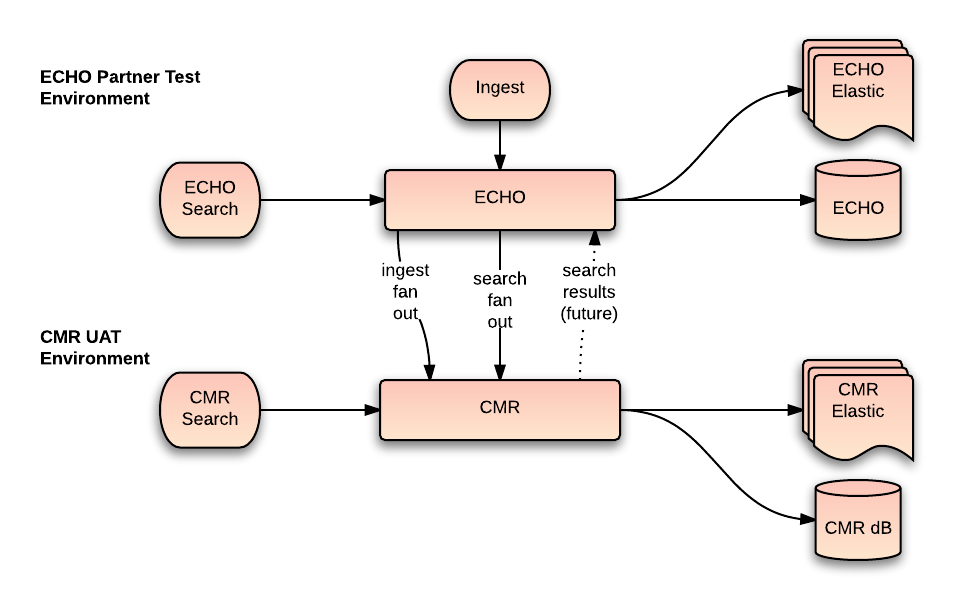- Created by user-e422b, last modified on Apr 20, 2015
You are viewing an old version of this page. View the current version.
Compare with Current View Page History
« Previous Version 2 Next »
The Common Metadata Repository (CMR) catalogues all data and service metadata records for the EOSDIS system. These metadata records are registered, modified, discovered, and accessed through programmatic interfaces leveraging standard protocols and APIs.
- CMR will be the authoritative management system for all EOSDIS metadata for all EOSDIS data holdings.
- CMR is a common middleware replacement for for the ECHO backend and GCMD’s backend. The GCMD frontend, however, will not change and users of GCMD should see no impact.
- CMR is designed to handle metadata at the Concept level beyond just Collections and Granules to Visualizations, Parameters, Documentation, Services, and more.
- CMR is designed around an evolvable Unified Metadata Model (UMM).
- CMR is designed to handle hundreds of millions of metadata records; making them available through high performance, standards compliant, temporal, spatial, and faceted search.
- CMR incorporates both human and machine metadata assessment features that work to ensure the highest quality metadata possible
The Unified Metadata Model is a model that encompasses various metadata profiles maintained and archived by EOSDIS. The UMM will be used by the Common Metadata Repository and will drive search and retrieval of metadata cataloged within that system.
Quick overview:
- UMM stands for Unified Metadata Model
- UMM profiles are not metadata standards
- UMM-C represents Collection Metadata
- UMM-G represents Granule Metadata
- UMM-S represents Service Metadata (TBD)
- UMM-V represents Visualization Metadata (TBD)
- UMM-P represents Parameter Metadata (TBD)
- New UMM profiles will be added in the future.
More details:
First a link to a presentation: AGU Fall 2014 - Streamlining Metadata in NASA EOSDIS CMR
To increase the level of quality and consistency among its metadata holdings, EOSDIS has developed (and continues to develop and expand) a model for various metadata profiles that it archives and maintains. This model aims to document vital elements that may be represented across various metadata formats and standards and unify them through core fields useful for data discovery and service invocations. This unified model, aptly named the Unified Metadata Model (UMM), has been developed as part of the EOSDIS Metadata Architecture Studies (MAS I and II) conducted between 2012 and 2013.
The UMM will be used by the Common Metadata Repository (CMR) and will drive search and retrieval of metadata cataloged within that system.
All UMM profiles will be mapped to the ISO 19115 metadata model as shown in the diagram below.

All search and ingest that are done via ECHO now will continue to be serviced. The ECHO API will work seamlessly with the CMR and will be backwards compatible. However, there is a period of transition from returning ECHO results to returning CMR results. During this transition period, ECHO will fan-out ingest and search requests to the CMR system.
For more information, please email support@earthdata.nasa.gov and include 'CMR' in the email subject.
The diagram below outlines the high-level interaction between these systems:

There is preliminary documentation on the search API currently deployed in the UAT environment that can be found here:
2015 ESIP Winter Meeting Session
AGU Fall 2014 (login required)
- IN51C-02 Streamlining Metadata in NASA's EOSDIS Common Metadata Repository
- IN53B-3805 Achieving Sub-Second Search in the CMR
2014 DAAC System Engineering Technical Interchange
- Project Status
- Systems Engineering
- Software Design/Development/Implementation
- Operations Status
- DAAC Roles
- Achieving Sub-second Search
ESIP Winter 2014
Helpful Links
CMR Quality Software Wiki (GCMD wiki)
Related Work
Global Imagery Browse Services - GIBS
Legacy Links
Metadata Architecture Study 2 Wiki
- No labels